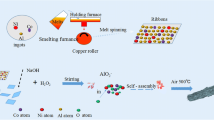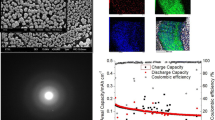Abstract
Thin films having nanocolumnar arrays made of various Si–Cu atomic ratios (90–10, 80–20, 70–30 %) are fabricated by an ion-assisted oblique angle co-deposition technique to produce stable negative electrodes for lithium-ion batteries. Cu is added into the electrode because of its ductility and electron conductivity. Cu plays a crucial role in holding the electrode together, minimizing overall capacity loss and enabling faster electron transfer. Plus, Cu is inactive versus Li+; therefore, Si–Cu variation is expected to affect the electrochemical performances of the electrodes. In this work, the effect of Si–Cu atomic ratios on the morphologies and the structures of the electrodes are studied. Plus, the uses of these nanocolumns with different Cu contents are evaluated as anodes by electrochemical tests. The morphological analyses demonstrate that an increase in Si–Cu atomic ratio affects the width of the nanocolumns and the homogeneity of the thin film morphology. The increase in Cu content dramatically improves the capacity retention of Si–Cu anodes, whereas it decreases the initial discharge capacity.







Similar content being viewed by others
References
Tani J-I, Kido H (2013) Fabrication and thermoelectric properties of Mg2Si-based composites using reduction reaction with additives. Intermetallics 32:72–80. doi:10.1016/j.intermet.2012.08.026
Kim H, Lee E-J, Sun Y-K (2014) Recent advances in the Si-based nanocomposite materials as high capacity anode materials for lithium ion batteries. Mater Today 17:285–297
Armelao L, Barreca D, Bottaro G et al (2006) Recent trends on nanocomposites based on Cu, Ag and Au clusters: a closer look. Coord Chem Rev 250:1294–1314. doi:10.1016/j.ccr.2005.12.003
Beecroft LL, Ober CK (1997) Nanocomposite materials for optical applications. Chem Mater 9:1302–1317. doi:10.1021/cm960441a
He YP, Yang B, Yang KK et al (2012) Designing Si-based nanowall arrays by dynamic shadowing growth to tailor the performance of Li-ion battery anodes. J Mater Chem 22:8294–8303. doi:10.1039/C2JM00003B
Su X, Wu QL, Li JC et al (2014) Silicon-based nanomaterials for lithium-ion batteries: a review. Energy Mater, Adv. doi:10.1002/aenm.201300882
Magasinski A, Dixon P, Hertzberg B et al (2010) High-performance lithium-ion anodes using a hierarchical bottom-up approach. Nat Mater 9:461. doi:10.1038/nmat.2725
Mao O, Dahn JR (1999) Mechanically alloyed Sn-Fe(-C) powders as anode materials for Li-ion batteries—III. Sn2Fe: SnFe3C active/inactive composites. J Electrochem Soc 146:423–427. doi:10.1149/1.1391624
Chan CK, Peng HL, Liu G (2008) High-performance lithium battery anodes using silicon nanowires. Nat Nanotech 3:31–35. doi:10.1038/nnano.2007.411
Kohandehghan A, Cui K, Kupsta M, Memarzadeh E, Kalisvaart P, Mitlin D (2014) Nanometer-scale Sn coatings improve the performance of silicon nanowire LIB anodes. J Mater Chem A. 2:11261–11279. doi:10.1039/C4TA00993B
Lotfabad EM, Kalisvaart P, Kohandehghan A, Cui K, Kupsta M, Parbod B, Mitlin D (2014) Si nanotubes ALD coated with TiO2, TiN or Al2O3 as high performance lithium ion battery anodes. J Mater Chem A 2:2504–2516. doi:10.1039/C3TA14302C
Kohandehghan A, Kalisvaart P, Cui K, Kupsta M, Lotfabad E, Mitlin D (2013) Silicon nanowire lithium-ion battery anodes with ALD deposited TiN coatings demonstrate a major improvement in cycling performance. J Mater Chem A. doi:10.1039/C3TA12964K
Wu H, Chan G, Choi JW, Ryu I, Yao Y, McDowell MT, Lee SW, Jackson A, Yang Y, Hu L, Cui Y (2012) Stable cycling of double-walled silicon nanotube battery anodes through solid-electrolyte interphase control. Nat Nanotech. 17:310–315. doi:10.1038/nnano.2012.35
Yao Y, McDowell MT, Ryu I, Wu H, Liu N, Hu L, Nix WD, Cui Y (2011) Interconnected silicon hollow nanospheres for lithium-ion battery anodes with long cycle life. Nano Lett 11:2949–2954. doi:10.1021/nl201470j
Jia HP, Gao PF, Yang J, Wang JL, Nuli YN, Yang Z (2011) Novel three-dimensional mesoporous silicon for high power lithium-ion battery anode material. Adv Energy Mater 6:1036–1039. doi:10.1002/aenm.201100485
Sethuraman VA, Kowolik K, Srinivasan V (2011) Increased cycling efficiency and rate capability of copper-coated silicon anodes in lithium-ion batteries. J Power Sources 196:393–398. doi:10.1016/j.jpowsour.2010.06.043
Maranchi JP, Hepp AF (2003) High capacity, reversible silicon thin-film anodes for lithium-ion batteries. Electrochem Solid State Lett 6:A198–A201. doi:10.1149/1.1596918
He YP, Brown C, Lundgren CA et al (2012) The growth of CuSi composite nanorod arrays by oblique angle co-deposition, and their structural, electrical and optical properties. Nanotechnology 23:365703. doi:10.1088/0957-4484/23/36/365703
Robbie K, Brett MJ (1997) Sculptured thin films and glancing angle deposition: growth mechanics and applications. J Vac Sci Technol A 15:1460–1465. doi:10.1116/1.580562
Thornton JA (1977) High rate thick film growth. Rev Mater Sci 7:239–260. doi:10.1146/annurev.ms.07.080177.001323
Dirks AG, Leamy HJ (1977) Columnar microstructure in vapor-deposited thin films. Thin Solid Films 47:219–233. doi:10.1016/0040-6090(77)90037-2
Trait RN, Smy T, Brett MJ (1993) Modeling and characterization of columnar growth in evaporated-films. Thin Solid Films 226:196–201. doi:10.1016/0040-6090(93)90378-3
Beaulieu LY, Cumyn VK, Eberman KW, Krause LJ, Dahn JR (2001) A system for performing simultaneous in situ atomic force microscopy/optical microscopy measurements on electrode materials for lithium-ion batteries. Rev Sci Instrum 72:3313–3319
He Y, Brown C, Lundgren CA, Zhao Y (2012) The growth of CuSi composite nanorod arrays by oblique angle co-deposition, and their structural, electrical and optical properties. Nanotechnology 23(365703):1–10. doi:10.1088/0957-4484/23/36/365703
Robbie K, Brett MJ (1997) Sculptured thin films and glancing angle deposition: growth mechanics and applications. J Vac Sci Tech 15:1460–1465. doi:10.1116/1.580562
Karabacak T, Wang GC, Lu TM (2004) Physical self-assembly and the nucleation of 3D nanostructures by oblique angle deposition. J Vac Sci Tech 22:1778–1784. doi:10.1116/1.1743178
Kasavajjula U, Wang C, Appleby AJ (2007) Nano and Bulk Si based insertion anodes for lithium ion secondary cells. J Power Sources 163:1003–1039. doi:10.1016/j.jpowsour.2006.09.084
Li H, Huang X, Chen L, Zhou H, Zhang Z, Yu D, Mo YJ, Pei N (2000) The crystal structural evolution of nano-Si anode caused by lithium insertion and extraction at room temperature. Solid State Ion 135:181–191. doi:10.1016/S0167-2738(00)00362-3
Limothongkul P, Jang YI, Dudney NJ, Chiang YM (2003) Electrochemically-driven solid-state amorphization in lithium-metal anodes. J Power Sources 119–121:604–609. doi:10.1016/S0378-7753(03)00303-3
Limothongkul P, Jang YI, Dudney NJ, Chiang YM (2003) Electrochemically-driven solid-state amorphization in lithium-silicon alloys and implications for lithium storage. Acta Mater 51:1103–1113. doi:10.1016/S1359-6454(02)00514-1
Thomson RD, Tu KN (1982) Low temperature gettering of Cu, Ag, and Au across a wafer of Si by Al. Appl Phys Lett 41:440–443. doi:10.1063/1.93565
Silverman A, Adler J (1990) Site-percolation threshold for a diamond lattice with diatomic substitution. Phys Rev B 42:1369–1373. doi:10.1103/PhysRevB.42.1369
Van der Mark SC (1998) Calculation of percolation thresholds in high dimensions for FCC, BCC and diamond lattices. Int J Modern Phys C 9(4):529–540. doi:10.1142/S0129183198000431
Xu X, Wang J, Lv J-P et al (2014) Simultaneous analysis of three-dimensional percolation models. Front Phys 9:113–119. doi:10.1007/s11467-013-0403-z
Vyssosky VA, Gordon SB, Frisch HL et al (1961) Critical percolation probabilities (bond problem). Phys Rev 123:1566–1567
Acharyya M, Stauffer D (1998) Nucleation and hysteresis in Ising model: classical theory versus computer simulation. Int J Mod Phys C 9:643–647
Ballesteros HG, Fernandez LA, Martin-Mayor V et al (1999) Critical exponents of the three dimensional diluted Ising model. Phys Rev 58:2740–2747. doi:10.1103/PhysRevB.58.2740
Deng YJ, Blote HWJ (2005) Monte Carlo study of the site-percolation model in two and three dimensions. Phys Rev E. doi:10.1103/PhysRevE.72.016126
Grassberger P (1992) Numerical studies of critical percolation in three dimensions. J Phys A 25:5867–5888
Jan N, Stauffer D (1998) Random site percolation in 3 dimensions. Int J Mod Phys C 9:341–347
Lorenz CD, Ziff RM (1998) Universality of the excess number of clusters and the crossing probability function in 3-dimensional percolation. J Phys A 31:8147–8157
Skvor J, Nezbeda I (2009) Percolation threshold parameters of fluids. Phys Rev E. doi:10.1103/PhysRevE.79.041141
Wang JF, Zhou ZZ, Zhang W et al (2013) Bond and site percolation in three dimensions. Phys Rev E. doi:10.1103/PhysRevE.87.052107
Dammer SM, Hinrichsen H (2004) Spreading with immunization in high dimensions. J Stat Mech Theor Exp. doi:10.1088/1742-5468/2004/07/P07011
Lorenz CD, Ziff RM (1998) Precise determination of the bond percolation thresholds and finite-size scaling corrections for the sc, fcc, and bcc lattices. Phys Rev E 57:230–236
Bradley RM, Strenski PN, Debierre JM (1991) Surfaces of percolation clusters in three dimensions. Phys. Rev. B 44:76–84
Gaunt DS, Sykes MF (1983) Series study of random percolation in three dimensions. J Phys A 16:783–799. doi:10.1088/0305-4470/16/4/016
Van Der Marck SC (1998) Calculation of percolation thresholds in high dimensions fcc, bcc and diamond lattices. Int J Mod Phys C 9:529–540
Lorenz CD, May R, Ziff RM (2000) Similarity of percolation thresholds on the HCP and FCC lattices. J Stat Phys 98:961–970
Garboczi EJ, Snyder KA, Douglas JF et al (1995) Geometrical percolation threshold of overlap** ellipsoids. Phys Rev E 52:819–828
Lorenz CD, Ziff RM (2001) Precise determination of the critical percolation threshold for the threedimensional “Swiss cheese” model using a growth algorithm. J Chem Phys 114:3659–3661. doi:10.1063/1.1338506
Rintoul MD, Torquato S (1997) Precise determination of the critical threshold and exponents in a three-dimensional continuum percolation model. J Phys A 30:L585–L592
Acknowledgements
This work is a part of the research Project 213M511 approved by The Scientific and Technological Research Council of Turkey (TUBİTAK). Research at Argonne National Laboratory was funded by the U.S. Department of Energy (DOE), Vehicle Technologies Office. Argonne National Laboratory is operated for the US Department of Energy by UChicago Argonne, LLC, under contract DE-AC02-06CH11357.
Author information
Authors and Affiliations
Corresponding authors
Rights and permissions
About this article
Cite this article
Polat, B.D., Keles, O., Chen, Z.H. et al. Si–Cu alloy nanowires grown by oblique angle deposition as a stable negative electrode for Li-ion batteries. J Mater Sci 51, 6207–6219 (2016). https://doi.org/10.1007/s10853-016-9918-3
Received:
Accepted:
Published:
Issue Date:
DOI: https://doi.org/10.1007/s10853-016-9918-3




